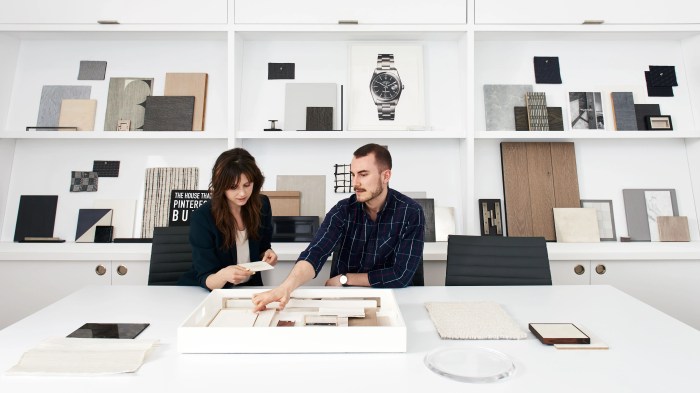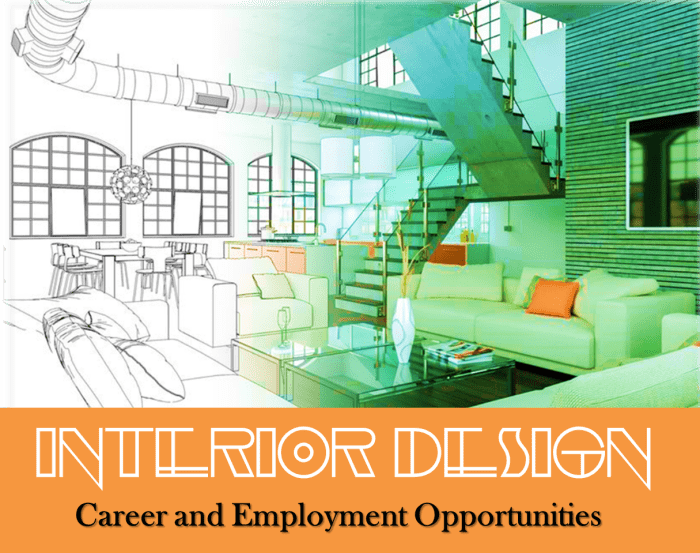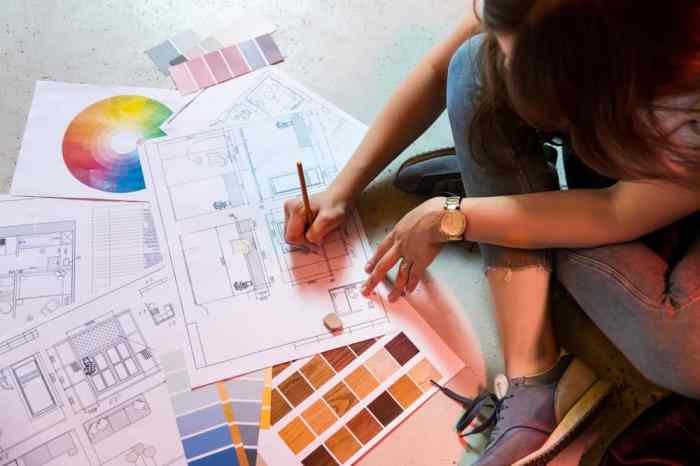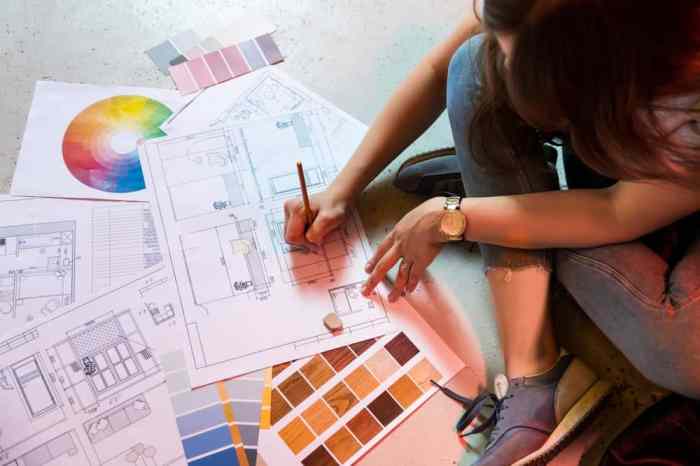Careers in housing and interior design set the stage for this enthralling narrative, offering readers a glimpse into a story that is rich in detail and brimming with originality from the outset. This field encompasses a wide range of roles, from designing stunning residential spaces to crafting functional and aesthetically pleasing commercial interiors.
It’s a dynamic industry that blends creativity with practicality, offering individuals the opportunity to shape spaces that inspire and enhance lives.
Whether you’re drawn to the challenge of creating cozy homes, designing innovative commercial spaces, or incorporating sustainable design principles, a career in housing and interior design presents a wealth of possibilities. From understanding client needs and preferences to mastering design software and tools, this field demands a diverse set of skills and a passion for creating beautiful and functional environments.
Interior Design Software and Tools
Interior design software has become an indispensable tool for professionals in the field, enabling them to create stunning visuals, plan layouts, and communicate their design ideas effectively to clients. These software programs offer a wide range of features, from 2D and 3D modeling to rendering and visualization, empowering designers to bring their creative visions to life.
Commonly Used Interior Design Software, Careers in housing and interior design
Interior design software is essential for professionals to create detailed plans, visualizations, and presentations for their clients.
- Autodesk Revit:Revit is a Building Information Modeling (BIM) software widely used for architectural and interior design. It allows designers to create detailed 3D models of spaces, including walls, floors, ceilings, and furniture. Revit’s advanced features include parametric modeling, clash detection, and construction documentation.
- SketchUp:SketchUp is a user-friendly 3D modeling software popular among interior designers for its intuitive interface and ease of use. It allows designers to create quick sketches and detailed models, import 3D objects, and generate realistic renderings.
- Chief Architect:Chief Architect is a specialized software designed for residential and commercial interior design. It offers a comprehensive set of tools for creating floor plans, elevations, and 3D models. Chief Architect also includes features for creating photorealistic renderings and generating construction documents.
Careers in housing and interior design are diverse, ranging from traditional home styles to more contemporary trends. One particularly popular niche is the beach house modern interior design aesthetic, which combines elements of natural materials, light colors, and open spaces to create a relaxed and inviting atmosphere.
This area of specialization offers exciting opportunities for designers who enjoy creating spaces that reflect the beauty and serenity of coastal living.
- Floorplanner:Floorplanner is a cloud-based software that provides a simple and affordable way to create 2D and 3D floor plans. It offers a user-friendly interface, a wide selection of furniture and objects, and the ability to share plans with clients online.
- Sweet Home 3D:Sweet Home 3D is a free and easy-to-use software that allows users to create 2D and 3D floor plans of their homes. It offers a wide selection of furniture and objects, and the ability to generate realistic renderings.
Functionalities and Benefits of Design Software Programs
Interior design software offers a variety of functionalities that benefit designers in numerous ways.
- 2D and 3D Modeling:Design software allows designers to create detailed 2D and 3D models of spaces, enabling them to visualize the layout, furniture placement, and overall design aesthetic.
- Rendering and Visualization:Rendering capabilities allow designers to create photorealistic images and animations of their designs, providing clients with a clear understanding of the final outcome.
- Material Libraries:Most design software programs include extensive material libraries, offering a wide range of textures, finishes, and colors for designers to choose from.
- Furniture and Object Libraries:These libraries provide designers with a vast selection of furniture, appliances, and other objects to incorporate into their designs, ensuring realistic and accurate representations.
- Collaboration Tools:Some design software programs offer collaboration features, allowing designers to work on projects together and share files with clients in real-time.
- Construction Documentation:Design software can generate construction drawings, specifications, and other documentation necessary for building projects, streamlining the design and construction process.
Comparison of Popular Design Software
| Software | Features | Pricing ||—|—|—|| Autodesk Revit | BIM, parametric modeling, clash detection, construction documentation | Subscription-based || SketchUp | 3D modeling, intuitive interface, import 3D objects, rendering | Subscription-based and perpetual license options || Chief Architect | Residential and commercial design, floor plans, elevations, 3D models, renderings, construction documents | Perpetual license || Floorplanner | 2D and 3D floor plans, user-friendly interface, furniture and object libraries, online sharing | Subscription-based || Sweet Home 3D | 2D and 3D floor plans, free software, furniture and object libraries, rendering | Free |
The Business of Interior Design

Interior design is a creative field that involves much more than just aesthetics. It’s a business, and understanding its intricacies is crucial for success. This section will delve into the business aspects of interior design, exploring various business models, marketing strategies, and essential management practices.
Business Models
Interior design firms can operate under various business models, each with its own advantages and disadvantages.
- Sole Proprietorship:This model is ideal for starting small. The designer is the sole owner and responsible for all aspects of the business, including finances, marketing, and project management. It’s simple to set up but comes with unlimited liability.
- Partnership:Two or more designers collaborate, sharing profits, losses, and responsibilities. It allows for shared expertise and resources, but requires strong communication and agreement on business decisions.
- Limited Liability Company (LLC):This structure provides personal liability protection for the owners, separating their personal assets from business liabilities. It offers flexibility in management and taxation, but requires more complex legal setup and reporting.
- Corporation:This model provides the highest level of liability protection and offers potential for growth and expansion. However, it involves complex legal and regulatory requirements and can be more expensive to set up and maintain.
Marketing and Networking
Building a successful interior design practice requires effective marketing and networking.
- Online Presence:A professional website and social media accounts are essential for showcasing your portfolio, services, and contact information. Engage with potential clients through content marketing, sharing design inspiration, and project updates.
- Networking Events:Attending industry events, trade shows, and local gatherings allows you to connect with potential clients, collaborators, and other professionals in the field. Building relationships with architects, builders, and real estate agents can lead to referrals and collaborations.
- Referrals:Satisfied clients are your best advocates. Encourage them to recommend your services to their friends, family, and colleagues. Offer incentives or referral programs to encourage word-of-mouth marketing.
- Public Relations:Seek opportunities to be featured in local publications, blogs, or online media. Sharing your expertise through articles, interviews, or guest posts can raise your profile and attract new clients.
Project Management
Efficient project management is crucial for delivering projects on time and within budget.
- Clear Communication:Establish clear communication channels with clients and contractors. Maintain detailed documentation of project scope, timelines, and budget to avoid misunderstandings and delays.
- Project Planning:Develop a detailed project plan that Artikels all tasks, deadlines, and resources needed. Utilize project management tools to track progress, assign responsibilities, and manage deadlines.
- Budgeting and Cost Control:Create a comprehensive budget that includes all project expenses, such as materials, labor, and fees. Track expenses diligently and communicate any potential cost overruns to clients promptly.
- Vendor Management:Establish relationships with reliable contractors, suppliers, and vendors. Negotiate competitive rates and ensure timely delivery of materials and services.
Financial Management
Managing finances effectively is essential for the long-term success of any design business.
- Accounting and Bookkeeping:Maintain accurate financial records, including income, expenses, and invoices. Utilize accounting software to streamline financial management and generate reports for tax purposes.
- Pricing Strategies:Develop a pricing strategy that reflects your expertise, experience, and the value you bring to clients. Consider hourly rates, project-based fees, or a combination of both.
- Cash Flow Management:Monitor cash flow to ensure you have sufficient funds to cover operating expenses and pay invoices. Implement strategies to improve cash flow, such as offering payment plans or negotiating payment terms with clients.
- Investment and Growth:Allocate a portion of your profits to reinvest in your business, such as upgrading equipment, hiring staff, or expanding your services. This can help you grow your practice and achieve long-term success.
Client Relationships
Building strong client relationships is fundamental to any successful interior design practice.
- Active Listening:Understand your clients’ needs, preferences, and goals. Ask questions, listen attentively, and demonstrate empathy to build trust and rapport.
- Clear Expectations:Set clear expectations regarding scope, timelines, and budget. Provide regular updates and communicate any changes or challenges promptly.
- Professionalism and Ethics:Maintain professional conduct at all times, respecting client confidentiality and adhering to industry standards and ethical guidelines.
- After-Sales Service:Provide excellent after-sales service, addressing any concerns or issues promptly and efficiently. This fosters positive client relationships and encourages referrals.
Emerging Trends in Housing and Interior Design

The field of housing and interior design is constantly evolving, driven by technological advancements, changing lifestyles, and societal preferences. This dynamic landscape is shaping the way we live, work, and interact with our spaces.
Smart Home Technology
Smart home technology is revolutionizing the way we interact with our homes, enhancing convenience, comfort, and security.
- Voice Assistants:Devices like Amazon Alexa and Google Assistant are becoming ubiquitous, allowing homeowners to control lighting, temperature, and appliances with voice commands.
- Home Automation Systems:These systems integrate various smart devices, enabling automated tasks like locking doors, adjusting thermostats, and monitoring security cameras.
- Internet of Things (IoT):The interconnectedness of devices allows for seamless communication and data exchange, creating a more intelligent and responsive living environment.
Smart home technology is not just about convenience; it also offers energy efficiency and personalized experiences.
Minimalist Aesthetics
Minimalism has gained significant traction in interior design, emphasizing simplicity, functionality, and clean lines.
- Open Floor Plans:Minimalist designs often feature open floor plans that maximize space and create a sense of flow.
- Neutral Color Palettes:A focus on neutral colors like white, gray, and beige creates a calm and serene atmosphere, allowing for pops of color through furniture and accessories.
- Decluttering and Organization:Minimalist design encourages decluttering and maximizing storage space to maintain a sense of order and tranquility.
Minimalist aesthetics appeal to a desire for simplicity and a less cluttered lifestyle.
Influence of Social Media and Popular Culture
Social media platforms like Instagram and Pinterest have become powerful forces in shaping interior design trends.
- Visual Inspiration:Social media provides a constant stream of visual inspiration, showcasing innovative design ideas, color palettes, and furniture styles.
- Trend Forecasting:The popularity of certain design elements on social media can be a leading indicator of emerging trends, influencing the choices of designers and homeowners.
- Community Building:Social media platforms facilitate the sharing of ideas and experiences, fostering a sense of community among design enthusiasts.
The influence of social media and popular culture is constantly evolving, creating a dynamic and ever-changing landscape in interior design.
Future Directions
The future of housing and interior design is likely to be characterized by a continued focus on sustainability, technology integration, and personalized experiences.
- Sustainable Design:Increasing awareness of environmental concerns is driving the adoption of sustainable materials and practices in building and design.
- Personalized Spaces:Technology will enable greater personalization in home design, allowing for customized lighting, temperature, and entertainment experiences.
- Blurred Lines Between Indoor and Outdoor:The boundaries between indoor and outdoor spaces will continue to blur, with designs incorporating natural elements and maximizing outdoor living areas.
The future of housing and interior design promises to be innovative and exciting, reflecting a growing emphasis on sustainability, technology, and personalized experiences.
Outcome Summary: Careers In Housing And Interior Design

As we’ve explored the exciting world of housing and interior design, it’s clear that this field is constantly evolving, driven by technological advancements, shifting design trends, and a growing emphasis on sustainability. Whether you’re an aspiring designer or a seasoned professional, there’s always something new to learn and discover in this dynamic industry.
By embracing creativity, technical proficiency, and a genuine passion for shaping spaces, individuals can carve out fulfilling and impactful careers in housing and interior design.
Questions and Answers
What are the common job titles in housing and interior design?
Some common job titles include Interior Designer, Residential Designer, Commercial Designer, Space Planner, and Design Consultant.
Is a degree required for a career in housing and interior design?
While a degree is not always mandatory, it can provide a competitive edge and open up more opportunities. Many employers prefer candidates with a Bachelor’s or Associate’s degree in Interior Design, Architecture, or a related field.
What are the average salaries for interior designers?
Salaries can vary depending on experience, location, and specialization. According to the U.S. Bureau of Labor Statistics, the median annual salary for interior designers was $56,540 in 2021.
What are some essential skills for interior designers?
Essential skills include creativity, artistic ability, spatial reasoning, communication, problem-solving, project management, and knowledge of design software and tools.

